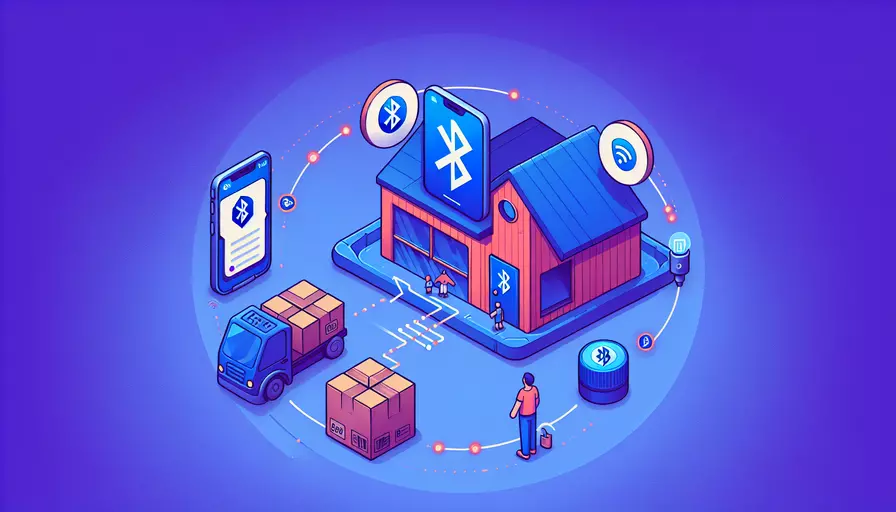
在Vue开发中连接蓝牙,1、使用Web Bluetooth API、2、确保浏览器和设备支持、3、正确处理权限和连接逻辑。Web Bluetooth API 使得网页可以与蓝牙设备进行通信,实现这一功能需要兼容的浏览器和设备,以及对权限请求和错误处理的良好管理。下面将详细介绍如何在Vue应用中实现蓝牙连接。
一、使用Web Bluetooth API
Web Bluetooth API 是一个现代浏览器提供的接口,可以让网页与附近的蓝牙设备通信。以下是实现的基本步骤:
- 检查浏览器是否支持 Web Bluetooth API。
- 请求蓝牙设备。
- 连接到设备并获取服务。
- 读取和写入特征值。
// 检查浏览器是否支持 Web Bluetooth API
if (!navigator.bluetooth) {
console.error('Web Bluetooth API is not available in this browser!');
}
// 请求蓝牙设备
navigator.bluetooth.requestDevice({ filters: [{ services: ['battery_service'] }] })
.then(device => {
// 连接到设备
return device.gatt.connect();
})
.then(server => {
// 获取服务
return server.getPrimaryService('battery_service');
})
.then(service => {
// 获取特征值
return service.getCharacteristic('battery_level');
})
.then(characteristic => {
// 读取特征值
return characteristic.readValue();
})
.then(value => {
console.log('Battery level is ' + value.getUint8(0) + '%');
})
.catch(error => {
console.error('There was an error:', error);
});
二、确保浏览器和设备支持
并非所有浏览器和设备都支持 Web Bluetooth API。常见的支持浏览器包括:
- Chrome 56+ (Windows, macOS, Linux, Android)
- Opera 43+ (Windows, macOS, Linux, Android)
- Edge 79+ (Windows, macOS, Linux)
设备支持方面,确保你的蓝牙设备符合低功耗蓝牙(Bluetooth Low Energy, BLE)标准。
三、正确处理权限和连接逻辑
处理权限请求和连接逻辑是实现蓝牙连接的关键。以下是一些要点:
- 权限请求:浏览器需要用户授权才能访问蓝牙设备。
- 错误处理:处理各种可能的错误,例如设备未找到、连接失败等。
- 状态管理:管理设备连接状态,确保连接的稳定性和安全性。
new Vue({
el: '#app',
data: {
device: null,
server: null,
batteryLevel: null,
error: null
},
methods: {
connectToDevice() {
navigator.bluetooth.requestDevice({ filters: [{ services: ['battery_service'] }] })
.then(device => {
this.device = device;
return device.gatt.connect();
})
.then(server => {
this.server = server;
return server.getPrimaryService('battery_service');
})
.then(service => {
return service.getCharacteristic('battery_level');
})
.then(characteristic => {
return characteristic.readValue();
})
.then(value => {
this.batteryLevel = value.getUint8(0);
})
.catch(error => {
this.error = error;
});
}
}
});
四、在Vue组件中实现蓝牙连接
为了更好地组织代码,可以将蓝牙连接逻辑封装到Vue组件中。
<template>
<div>
<button @click="connectToDevice">Connect to Bluetooth Device</button>
<p v-if="batteryLevel !== null">Battery Level: {{ batteryLevel }}%</p>
<p v-if="error">Error: {{ error.message }}</p>
</div>
</template>
<script>
export default {
data() {
return {
device: null,
server: null,
batteryLevel: null,
error: null
};
},
methods: {
connectToDevice() {
navigator.bluetooth.requestDevice({ filters: [{ services: ['battery_service'] }] })
.then(device => {
this.device = device;
return device.gatt.connect();
})
.then(server => {
this.server = server;
return server.getPrimaryService('battery_service');
})
.then(service => {
return service.getCharacteristic('battery_level');
})
.then(characteristic => {
return characteristic.readValue();
})
.then(value => {
this.batteryLevel = value.getUint8(0);
})
.catch(error => {
this.error = error;
});
}
}
};
</script>
五、管理蓝牙连接的生命周期
要确保蓝牙连接的稳定性和安全性,需要管理连接的生命周期。包括连接、断开连接、重连等操作。
methods: {
connectToDevice() {
navigator.bluetooth.requestDevice({ filters: [{ services: ['battery_service'] }] })
.then(device => {
this.device = device;
this.device.addEventListener('gattserverdisconnected', this.onDisconnected);
return device.gatt.connect();
})
.then(server => {
this.server = server;
return server.getPrimaryService('battery_service');
})
.then(service => {
return service.getCharacteristic('battery_level');
})
.then(characteristic => {
return characteristic.readValue();
})
.then(value => {
this.batteryLevel = value.getUint8(0);
})
.catch(error => {
this.error = error;
});
},
onDisconnected(event) {
this.device = null;
this.server = null;
this.batteryLevel = null;
},
disconnectFromDevice() {
if (this.device && this.device.gatt.connected) {
this.device.gatt.disconnect();
}
}
}
六、处理蓝牙连接中的常见问题
在实际开发中可能遇到一些常见问题,例如连接失败、设备不响应等。以下是一些解决方案:
- 连接失败:确保设备在范围内且未被其他设备连接。
- 特征值读取失败:检查设备是否支持请求的服务和特征值。
- 权限问题:确保用户授予了必要的权限。
methods: {
connectToDevice() {
navigator.bluetooth.requestDevice({ filters: [{ services: ['battery_service'] }] })
.then(device => {
this.device = device;
this.device.addEventListener('gattserverdisconnected', this.onDisconnected);
return device.gatt.connect();
})
.then(server => {
this.server = server;
return server.getPrimaryService('battery_service');
})
.then(service => {
return service.getCharacteristic('battery_level');
})
.then(characteristic => {
return characteristic.readValue();
})
.then(value => {
this.batteryLevel = value.getUint8(0);
})
.catch(error => {
if (error.name === 'NotFoundError') {
this.error = 'No device found.';
} else if (error.name === 'NotSupportedError') {
this.error = 'Bluetooth not supported.';
} else {
this.error = error.message;
}
});
},
onDisconnected(event) {
this.device = null;
this.server = null;
this.batteryLevel = null;
},
disconnectFromDevice() {
if (this.device && this.device.gatt.connected) {
this.device.gatt.disconnect();
}
}
}
七、总结与建议
在Vue开发中连接蓝牙设备涉及多个步骤,包括使用Web Bluetooth API、确保浏览器和设备支持、正确处理权限和连接逻辑。通过封装Vue组件和管理连接生命周期,可以提高代码的可维护性和可靠性。遇到常见问题时,需及时排查和解决,以确保连接的稳定性和用户体验。
建议:
- 测试设备和环境:在实际开发中,确保在多个设备和浏览器环境中进行测试。
- 用户交互设计:为用户提供清晰的连接和错误提示信息,提高用户体验。
- 安全考虑:确保蓝牙连接的安全性,避免未经授权的设备访问。
通过合理的设计和实现,可以在Vue应用中实现高效和可靠的蓝牙连接功能。
相关问答FAQs:
1. Vue开发连接蓝牙的基本步骤是什么?
在Vue开发中,连接蓝牙设备通常需要以下几个基本步骤:
-
检查浏览器兼容性:首先,你需要确保你的目标浏览器支持Web Bluetooth API。目前,Web Bluetooth API在Chrome和Opera浏览器上是可用的,但在其他浏览器上可能不被支持。
-
请求蓝牙设备权限:在Vue组件中,你可以使用navigator.bluetooth.requestDevice()方法来请求用户授权访问他们的蓝牙设备。用户将会收到一个设备选择器,可以选择要连接的设备。
-
连接蓝牙设备:一旦用户选择了要连接的设备,你可以使用BluetoothDevice对象的connect()方法来建立与设备的连接。连接过程可能需要一些时间,因此你可以使用Vue的异步操作来处理连接过程。
-
与蓝牙设备进行通信:一旦与蓝牙设备建立了连接,你可以使用BluetoothDevice对象的方法和属性与设备进行通信。这可能包括读取设备的特征值、写入数据到设备、订阅设备的通知等等。
-
处理蓝牙设备的断开:当蓝牙设备断开连接时,你可以使用BluetoothDevice对象的onDisconnected事件来处理断开连接的情况。你可以在Vue组件中监听这个事件并采取适当的措施,比如重新连接设备或者显示一个断开连接的提示。
2. 如何在Vue中使用Web Bluetooth API连接蓝牙设备?
在Vue中使用Web Bluetooth API连接蓝牙设备需要以下几个步骤:
-
安装必要的库:首先,你需要在Vue项目中安装适用于Web Bluetooth API的库。你可以使用npm或者yarn来安装相关库,比如Web Bluetooth Polyfill。
-
创建Vue组件:接下来,你可以创建一个Vue组件来处理蓝牙连接。你可以在组件的methods中定义与蓝牙设备通信的方法,并在模板中绑定相关的事件和数据。
-
请求蓝牙设备权限:在Vue组件的方法中,你可以使用navigator.bluetooth.requestDevice()方法来请求用户授权访问蓝牙设备。你可以将该方法包装在一个异步函数中,以便在用户选择设备后继续执行后续操作。
-
连接蓝牙设备:一旦用户选择了要连接的设备,你可以使用BluetoothDevice对象的connect()方法来建立与设备的连接。你可以在Vue组件的方法中处理连接过程,并使用Vue的异步操作来等待连接完成。
-
与蓝牙设备进行通信:一旦与蓝牙设备建立了连接,你可以使用BluetoothDevice对象的方法和属性与设备进行通信。你可以在Vue组件的方法中定义读取和写入数据的方法,并在模板中绑定相关的事件和数据。
-
处理蓝牙设备的断开:当蓝牙设备断开连接时,你可以使用BluetoothDevice对象的onDisconnected事件来处理断开连接的情况。你可以在Vue组件中监听这个事件,并根据需要采取适当的措施。
3. 有没有一些示例代码来帮助我在Vue中连接蓝牙设备?
当然!以下是一个简单的示例代码,可以帮助你在Vue中连接蓝牙设备:
<template>
<div>
<button @click="connectToDevice">连接蓝牙设备</button>
<div v-if="connectedDevice">
<p>已连接到设备: {{ connectedDevice.name }}</p>
<button @click="readData">读取数据</button>
</div>
</div>
</template>
<script>
export default {
data() {
return {
connectedDevice: null,
};
},
methods: {
async connectToDevice() {
try {
const device = await navigator.bluetooth.requestDevice({
filters: [{ services: ['heart_rate'] }],
});
await device.gatt.connect();
this.connectedDevice = device;
} catch (error) {
console.error('连接设备时出错:', error);
}
},
async readData() {
try {
const service = await this.connectedDevice.gatt.getPrimaryService(
'heart_rate'
);
const characteristic = await service.getCharacteristic(
'heart_rate_measurement'
);
const value = await characteristic.readValue();
console.log('读取到的数据:', value);
} catch (error) {
console.error('读取数据时出错:', error);
}
},
},
};
</script>
在这个示例中,点击"连接蓝牙设备"按钮将会请求用户授权并连接到一个具有"heart_rate"服务的蓝牙设备。一旦连接成功,"已连接到设备"文本将会显示设备的名称,并且"读取数据"按钮将会触发读取数据的操作。请注意,这只是一个简单的示例,你可能需要根据实际情况进行适当的修改和扩展。
文章标题:如何vue开发连接蓝牙,发布者:worktile,转载请注明出处:https://worktile.com/kb/p/3615958

 微信扫一扫
微信扫一扫  支付宝扫一扫
支付宝扫一扫 